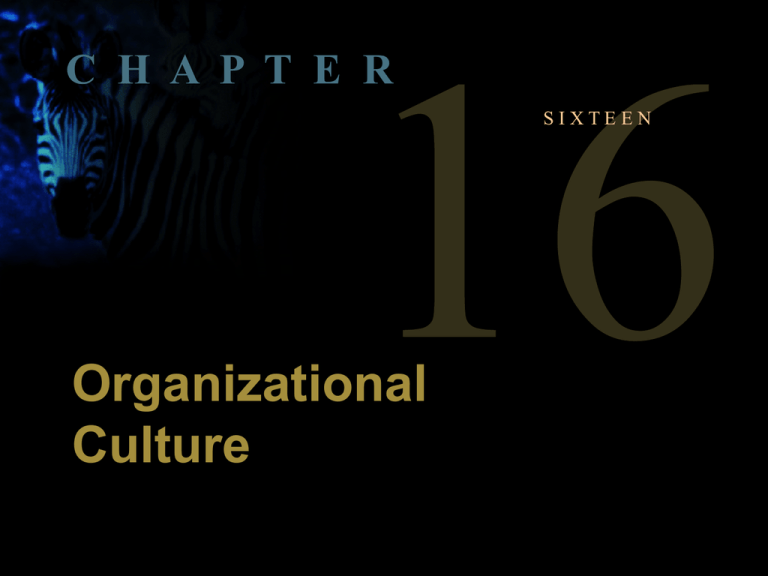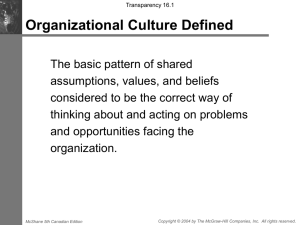
C H A P T E R
SIXTEEN
.
Organizational
Culture
McShane 5th Canadian Edition
1
Copyright © 2004 by The McGraw-Hill Companies, Inc. All rights reserved.
Van City’s Corporate Culture
Courtesy of VanCity
Vancouver City Savings Credit Union has applied a
values based business model to improve customer
service and employee relations and make it one of
Canada’s best companies to work for.
McShane 5th Canadian Edition
2
Copyright © 2004 by The McGraw-Hill Companies, Inc. All rights reserved.
Organizational Culture Defined
Courtesy of VanCity
The basic pattern of shared assumptions, values,
and beliefs considered to be the correct way of
thinking about and acting on problems and
opportunities facing the organization.
McShane 5th Canadian Edition
3
Copyright © 2004 by The McGraw-Hill Companies, Inc. All rights reserved.
Elements of Organizational Culture
Artifacts of
Organizational
Culture
Physical Structures
Language
Rituals and Ceremonies
Stories and Legends
Organizational
Culture
Beliefs
Values
Assumptions
McShane 5th Canadian Edition
4
Copyright © 2004 by The McGraw-Hill Companies, Inc. All rights reserved.
RIM’s Cultural Content
Research in Motion (RIM), the
Waterloo, Ontario pioneer in
wireless digital assistants, has
a strong organizational culture.
Founders Mike Lazaridis and
Jim Balsillie (shown) describe
the content of RIM’s culture as
intense, creative, fun,
inclusive, and collegial.
McShane 5th Canadian Edition
5
Kitchener-Waterloo Record
Copyright © 2004 by The McGraw-Hill Companies, Inc. All rights reserved.
Meaning of Cultural Content
• Cultural content refers to the
relative ordering of beliefs,
values, and assumptions.
• Example: RIM values
intensity whereas Q-Media
values thrift.
• An organization emphasizes
only a handful of the
hundreds of cultural values.
McShane 5th Canadian Edition
6
Kitchener-Waterloo Record
Copyright © 2004 by The McGraw-Hill Companies, Inc. All rights reserved.
Organizational Subcultures
• Located throughout the
organization
• Can enhance or oppose
(countercultures) firm’s
dominant culture
• Two functions of
countercultures:
– provide surveillance and
critique, ethics
– source of emerging values
McShane 5th Canadian Edition
7
Kitchener-Waterloo Record
Copyright © 2004 by The McGraw-Hill Companies, Inc. All rights reserved.
Artifacts: Stories and Legends
• Social prescriptions of desired (undesired)
behaviour
• Provides a realistic human side to
expectations
• Most effective stories and legends:
–
–
–
–
Describe real people
Assumed to be true
Known throughout the organization
Are prescriptive
McShane 5th Canadian Edition
8
Copyright © 2004 by The McGraw-Hill Companies, Inc. All rights reserved.
Artifacts: Rituals and Ceremonies
• Rituals
– programmed routines
– (eg., how visitors are greeted)
• Ceremonies
– planned activities for an audience
– (eg., award ceremonies)
McShane 5th Canadian Edition
9
Copyright © 2004 by The McGraw-Hill Companies, Inc. All rights reserved.
Artifacts: Organizational Language
• Words used to address people, describe
customers, etc.
• Leaders use phrases and special
vocabulary as cultural symbols
– eg. Container Store’s “Being Gumby”
Language also found in subcultures
– eg. Whirlpool’s “PowerPoint culture”
McShane 5th Canadian Edition
10
Copyright © 2004 by The McGraw-Hill Companies, Inc. All rights reserved.
Artifacts: Physical Structures and Symbols
• Building structure -- may shape and
reflect culture
– Mountain Equipment Co-op’s downtown Toronto
store roof holds a 10,000 square foot garden
with 4-inch thick soil
• Office design conveys cultural meaning
– Furniture, office size, wall hangings
McShane 5th Canadian Edition
11
Copyright © 2004 by The McGraw-Hill Companies, Inc. All rights reserved.
Benefits of Strong Corporate Cultures
Social
Control
Strong
Organizational
Culture
Social
Glue
Improves
Sense-Making
McShane 5th Canadian Edition
12
Copyright © 2004 by The McGraw-Hill Companies, Inc. All rights reserved.
Problems with Strong Cultures
• Culture content might be misaligned with
the organization’s environment.
• Strong cultures may focus on mental
models that could be limiting
• Strong cultures suppress dissenting
values from subcultures.
McShane 5th Canadian Edition
13
Copyright © 2004 by The McGraw-Hill Companies, Inc. All rights reserved.
Adaptive Organizational Cultures
• External focus -- firm’s
success depends on
continuous change
• Focus on processes more
than goals
• Strong sense of ownership
• Proactive --seek out
opportunities
AP/Wide World
McShane 5th Canadian Edition
14
Copyright © 2004 by The McGraw-Hill Companies, Inc. All rights reserved.
Bicultural Audit
• Part of “due diligence” in merger
• Minimizes risk of cultural collision by
diagnosing companies before merger
• Three steps in bicultural audit:
1. Examine artifacts
2. Analyze data for cultural conflict/compatibility
3. Identify strategies and action plans to bridge cultures
McShane 5th Canadian Edition
15
Copyright © 2004 by The McGraw-Hill Companies, Inc. All rights reserved.
Merging Organizational Cultures
Assimilation
Deculturation
Acquired company embraces
acquiring firm’s cultural values
Acquiring firm imposes its culture on
unwilling acquired firm
Integration
Cultures combined into a new
composite culture
Separation
Merging companies remain
separate with their own culture
McShane 5th Canadian Edition
16
Copyright © 2004 by The McGraw-Hill Companies, Inc. All rights reserved.
Strengthening Organizational Culture
Founders
and leaders
Selection
and
socialization
Strengthening
Organizational
Culture
Managing the
cultural
network
McShane 5th Canadian Edition
Culturally
consistent
rewards
Stable
workforce
17
Copyright © 2004 by The McGraw-Hill Companies, Inc. All rights reserved.
C H A P T E R
SIXTEEN
.
Organizational
Culture
McShane 5th Canadian Edition
18
Copyright © 2004 by The McGraw-Hill Companies, Inc. All rights reserved.







